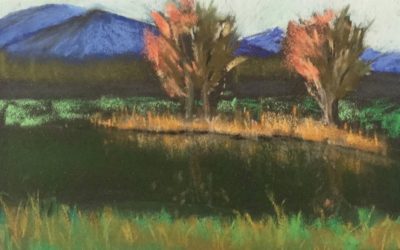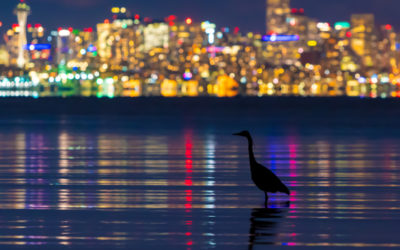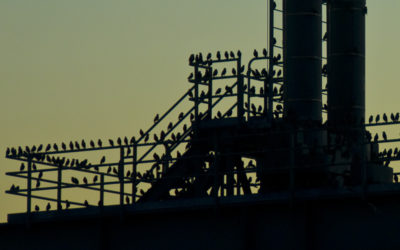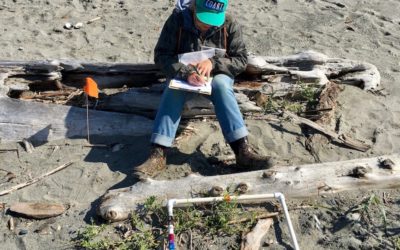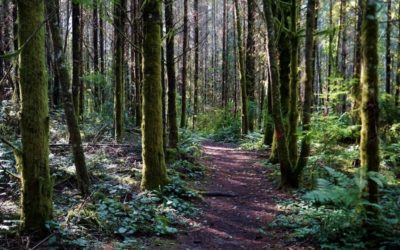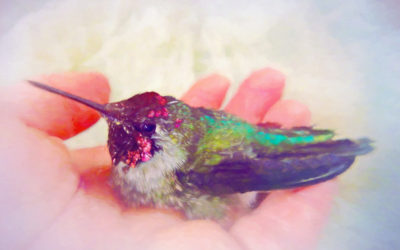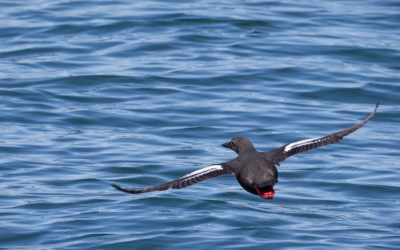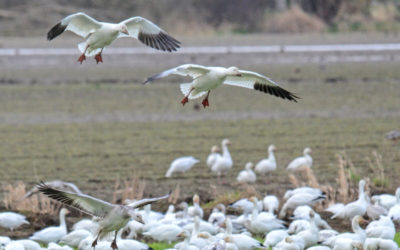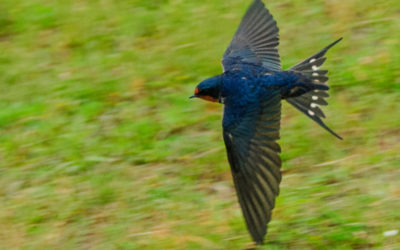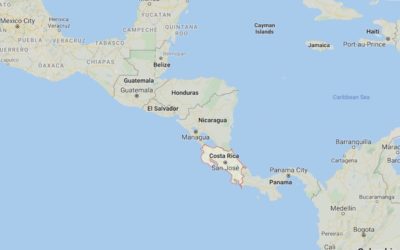HOME TWEET HOME FOR PURPLE MARTINS
by Gene Bullock, Winter 2019
Photo by John F. Williams
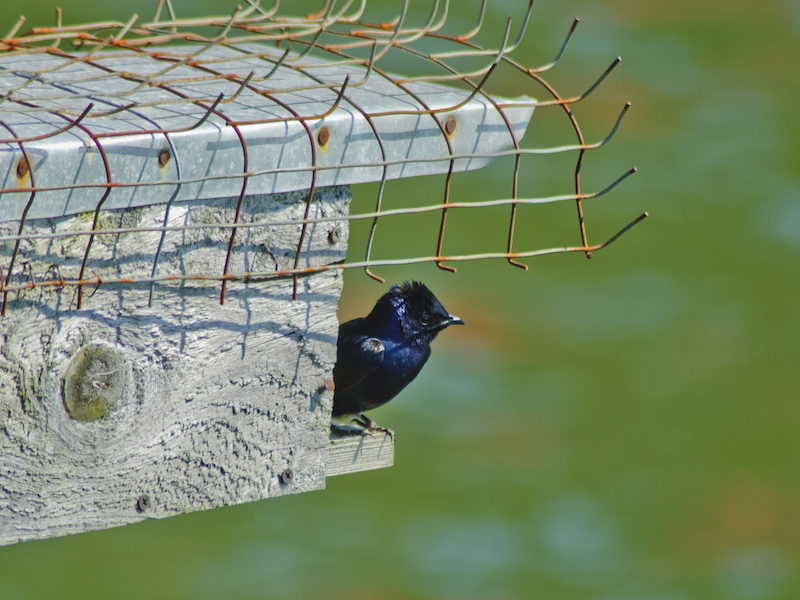
Photo by John F. Williams
HOME TWEET HOME FOR PURPLE MARTINS
by Gene Bullock, Winter 2019
Native Americans learned long ago that if they hung hollow gourds around their villages, they could attract Martins to nest in them. The birds repaid them by consuming large numbers of biting insects, pesky flies, and stinging wasps.
the birds & their homes
Purple Martins are the largest members of the swallow family, and live mostly on insects, which they scoop up in flight. Like Bluebirds and other cavity-nesting species of birds, however, they have been losing the competition for a dwindling number of natural nest cavities to invasive species, such as the House Sparrow and European Starling. The shrinking supply of natural nest cavities is mainly the result of forest clearing for agriculture and development. Adding to the problem, fastidious woodlot owners and gardeners consider dead trees untidy, as well as potential hazards to be recycled as firewood. Also referred to as “snags,” their decay and infestation by “bugs” is a natural and beneficial stage in the life of a healthy forest.
The Spanish word for woodpecker is “carpentero,” and these “forest carpenters” tirelessly excavate dead trees for food and shelter. Woodpeckers have always been the most prolific and dependable source of natural nest cavities in the wild. Dozens of species of birds and scores of other denizens of the forest depend on these cavities for shelter. Wildlife advocates and managers are working hard to make people aware of the irreplaceable role of dead trees in sustaining a healthy forest and its wild inhabitants.
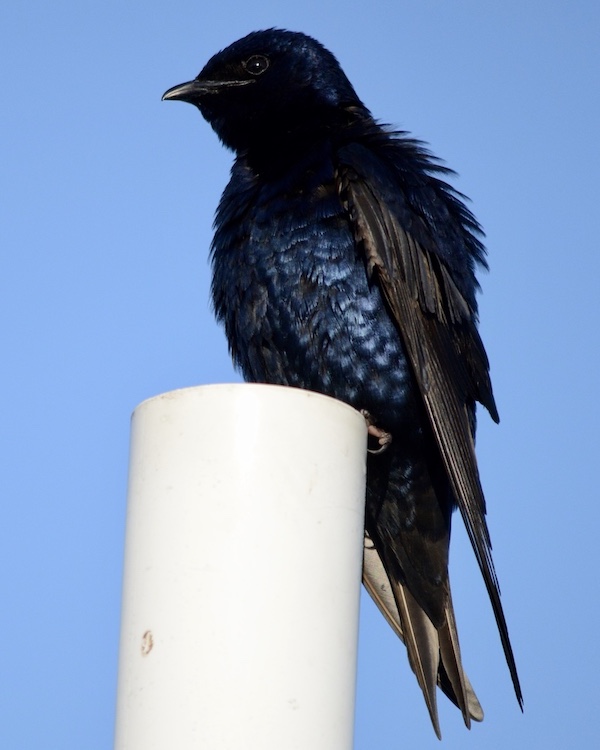
Male Purple Martin, photo by Jay Wiggs
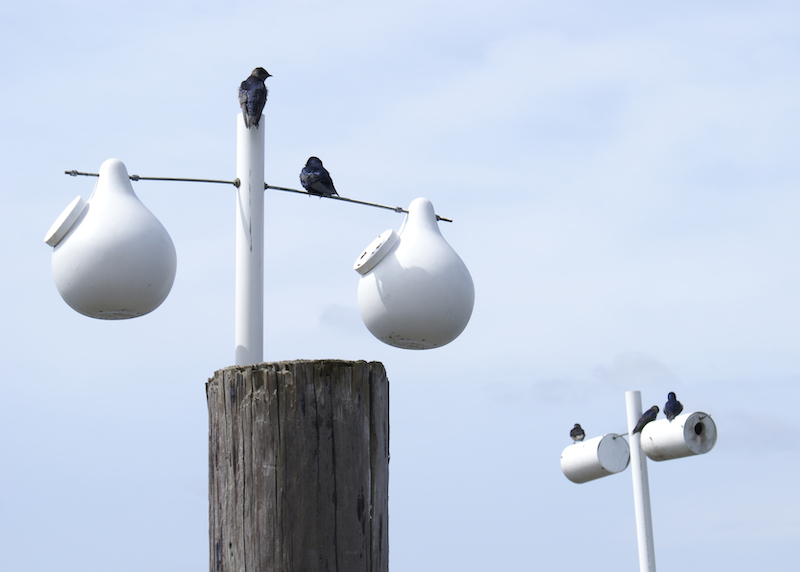
Photo by Gene Bullock
Faced with this growing threat, Purple Martins might have disappeared from North America altogether. But devoted friends intervened by creating man-made colonies for them in marinas and other waterfront locations. Purple Martins prefer to nest in colonies near the water’s edge, and readily adopt these homes, returning to them every spring to raise their families. Most Purple Martins winter in Mexico, and in Central and South America.
species
Eastern and Western subspecies differ somewhat in behavior. The Eastern subspecies has pretty much abandoned the wilds for man-made colonies. Some colonies consist of large multi-family apartment-style structures. Purple Martins are especially valued in the East for their insatiable appetite for mosquitoes. The Western subspecies still nests in the wild, usually in shoreline crevices and cavities. They shun multi-family “apartments,” but readily take up residence in artificial gourds and suitably designed nest boxes. Colonies are generally more successful when they overhang the water. It makes them less vulnerable to intruding House Sparrows and European Starlings. To further discourage undesirable tenants, installation is often delayed until just before the Purple Martins arrive each spring. Sometimes the birds show up just as the gourds are being installed, and wait patiently for volunteers to finish before moving in.
what they eat
Today, Purple Martins face new threats more serious than any they have faced before. Mounting research shows that insect diversity and abundance are plummeting all over the world.
 See Insect Freefall in the Find Out More section below.
See Insect Freefall in the Find Out More section below.
While insects are widely viewed as troublesome pests and threats to agriculture, they anchor natural systems and provide invaluable natural services as pollinators, scavengers, predators, and protein-packed food essential to the survival of many birds, fish, amphibians, reptiles, and mammals.
The large-scale disappearance of insects and related declines in bird populations points to such culprits as pesticides, habitat loss, and climate change.
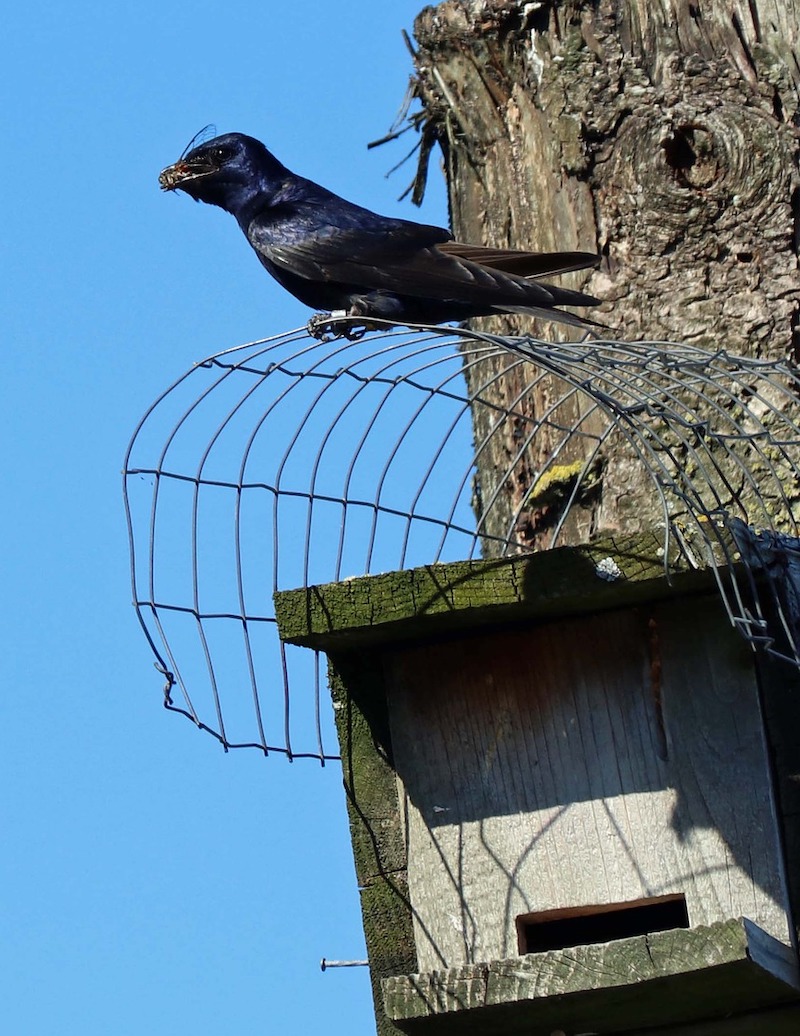
Image by JudaM from Pixabay
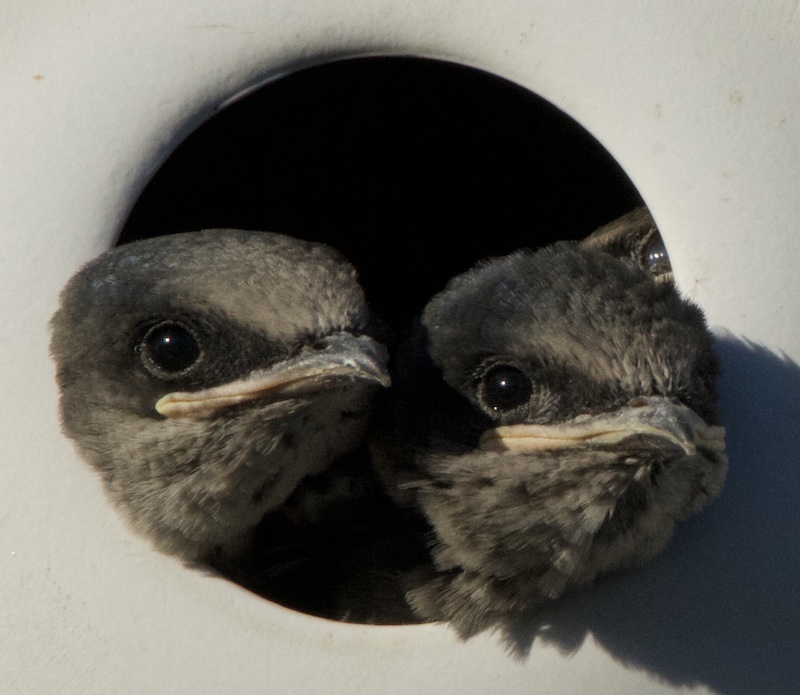
Photo by Jay Wiggs
Except for seabirds, 96% of North American bird species feed insects to their young. Species such as swallows that subsist mainly on insects have been hit the hardest.
Insects are also critically important to birds as pollinators, because many species depend on plant seeds and fruit for survival.
While pesticides may be the biggest culprit, the worldwide overuse of herbicides also takes a toll by decimating wild plants that insects depend on for food and reproduction, and that birds need for food and cover along the margins of farmland. For example, Monarch butterflies are rapidly declining because of the disappearance of milkweed, which is essential to their survival.
creating the future
It’s easy to feel helplessly overwhelmed by the global scale of these losses. But there is much we can do in our own yards to help our birds, wildlife, and the insects so necessary to their (and our) survival. We can stop using toxic chemicals, and create new habitat with wildlife-friendly native plants and shrubs. We can keep our cherished cats indoors. And we can turn our yards into safe havens that provide food, clean water, and shelter. Wildlife-friendly yards can help knit together what remains of their fragmented habitat.
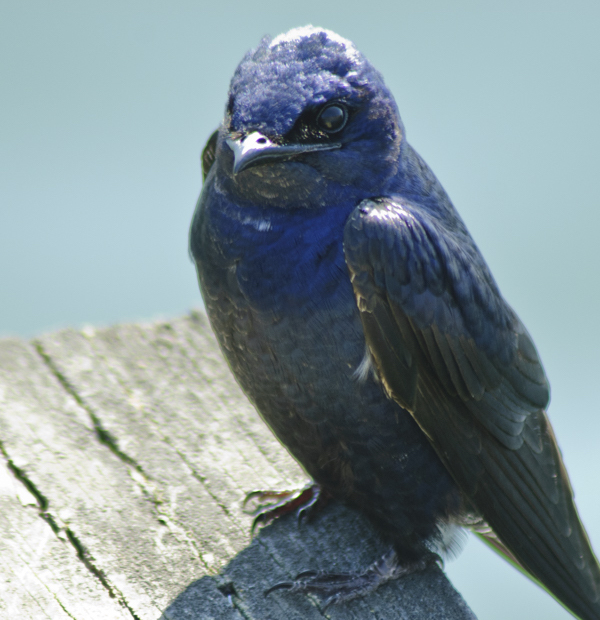
Photo by John F. Williams
some places you might see them
A number of Audubon chapters maintain Purple Martin colonies in the U.S. part of the Salish Sea region, and there are colonies on the Canadian islands as well.
 For info about Purple Martins in British Columbia, see BC Purple Martin Stewardship and Recovery Program in the Find Out More section below.
For info about Purple Martins in British Columbia, see BC Purple Martin Stewardship and Recovery Program in the Find Out More section below.
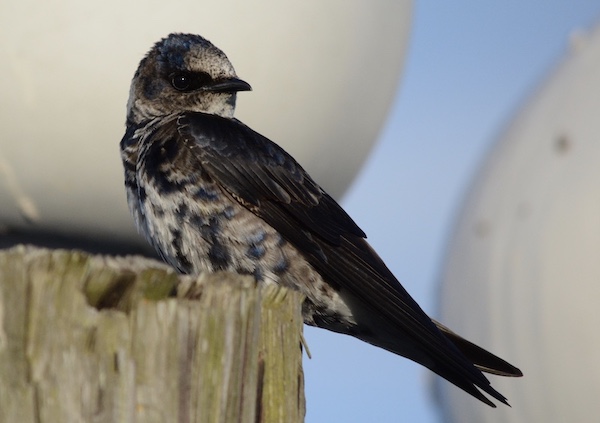
Female Purple Martin, photo by Jay Wiggs
Here are some examples of the kinds of places you might find Purple Martin colonies:
- In Kitsap County, there are colonies in Eagle Harbor in the Brownsville Marina, the Seabeck Marina, and Bainbridge Island. There are also privately owned colonies on Port Gamble Bay.
- The Olympic Peninsula Audubon chapter maintains colonies at the 3 Crabs restoration site in the Sequim area. There are a few nesting boxes on the pier at the Port Townsend Marine Science Center at Fort Worden State Park, and there are four boxes near the end of Point Hudson on the east end of the Port Townsend downtown district.
- There are several colonies along the Padilla Bay shoreline near the Padilla Bay Interpretive Center.
- There are also many on dock pilings circling Vashon Island.
If you’re looking for Purple Martins in a specific area, try contacting the local chapter of the Audubon Society.
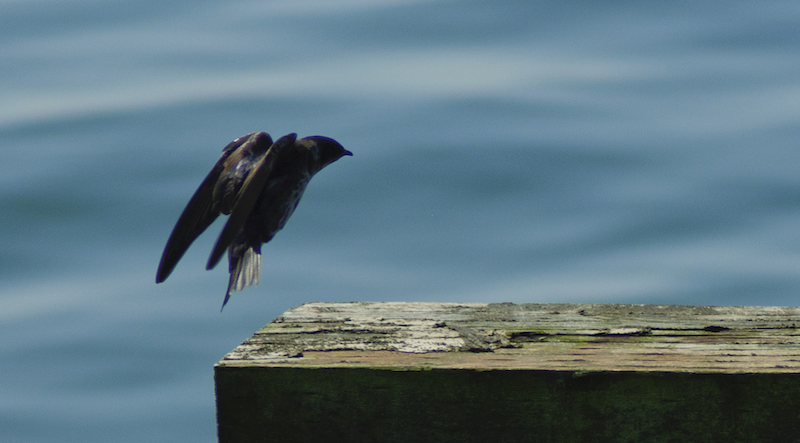
Photo by John F. Williams
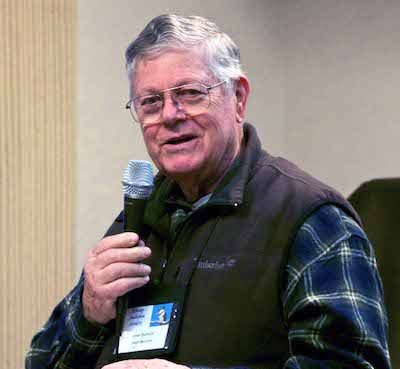
Gene Bullock is President, Education Chair, and Newsletter Editor for the Kitsap Audubon Society.
Table of Contents, Issue #6, Winter 2019
Birds of Bufflehead Pond
by Adelia Ritchie, Winter 2019Painting by Adelia Ritchieby Adelia Ritchie, Winter 2019 Such big ideas we had when we first set out to inhabit Bufflehead Pond Farm! The place had not been properly tended for years and the local ecology (mostly blackberries and...
Great Blue Heron
by Nancy Sefton, Winter 2019Photo by Philip HutchersonPhoto by Philip Hutchersonby Nancy Sefton, Winter 2019 As I floated in my kayak, I spotted a great blue heron perched on a mass of partially submerged roots. Suddenly it stabbed the water and came up with a small...
Poems-6
Winter 2019Winter 2019 Haiku by Nancy Rekow One heron standing.Mist hangs low in the valley.I will write to you.Painting by Kathleen Faulknerby Nancy TaylorIn Beacon Hill Park, Victoria B.C. I watch a bald eaglelight...
Citizen Science
by Todd Ramsey, Winter 2019Photo by Eric Wagner, COASST staffPhoto by Eric Wagner, COASST staffby Todd Ramsey, Winter 2019 It all started out so innocently. We just wanted to pick up trash on the beach after a storm. Soon after that we discovered COASST.org (Coastal...
Foto Tour 2
Showcase of Participant Photos North Kitsap Heritage Park from September 18, 2019 Showcase of Participant Photos North Kitsap Heritage Park from September 18, 2019 On September 18, 2019, WSU Extension in Kitsap County hosted a Forest Foto Expedition led by John F....
Should I Stay?
by Sharon Pegany, Winter 2019Artwork by Catherine WhalenArtwork by Catherine Whalenby Sharon Pegany, Winter 2019 turn of time rustle of feather echoing songs of beak and bill listen afresh to the voices among usWinter may be a quiet season in the Salish Sea region,...
Seabirds Are Cool
by Julia Parrish, Winter 2019Photo by Lee TenneboePhoto by Lee Tenneboeby Julia Parrish, Winter 2019 In Washington State, there is a bewildering abundance of seabirds. The seabirds of the surf zone that always capture my imagination are in the Alcid family: murres,...
The Russians Are Coming
by Paul Pegany, Winter 2019Photo by Catherine WhalenPhoto by Catherine Whalenby Paul Pegany, Winter 2019 The Russians are indeed coming! They are winged, white, and ready to spend their winter along the shores of the Salish Sea in northwest Washington. As the rain...
Barn Swallow
Nature's Pest Control by Adelia Ritchie, Winter 2019 Photos by John F. Williams except where notedNature's Pest Control by Adelia Ritchie, Winter 2019 Photos by John F. Williams except where notedClose cousin of the purple martin is our hard-working summertime...
Editorial-6
by Adelia Ritchie, Winter 2019by Adelia Ritchie, Winter 2019 On vacation in Costa Rica recently, I walked the city of San José one morning and visited a famous museum of pre-Colombian civilization, back when indigenous tribes lived in harmony with nature and as a...
PLEASE HELP SUPPORT
SALISH MAGAZINE
DONATE
Salish Magazine contains no advertising and is free. Your donation is one big way you can help us inspire people with stories about things that they can see outdoors in our Salish Sea region.
We also don't advertise Salish Magazine, so please spread the word of this online resource to your friends and colleagues.
Thanks so much for your interest and your support.
We also don't advertise Salish Magazine, so please spread the word of this online resource to your friends and colleagues.
Thanks so much for your interest and your support.
FIND OUT MORE
Insect Freefall: What does it mean for birds? Howard Youth, American Bird Conservancy, https://abcbirds.org/blog/insect-freefall/#homepage

